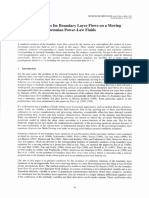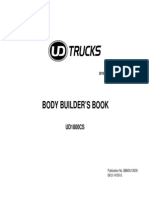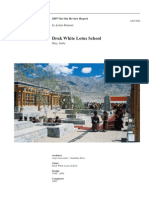Compression Test
Compression Test
Uploaded by
Salam AlbaradieCopyright:
Available Formats
Compression Test
Compression Test
Uploaded by
Salam AlbaradieOriginal Description:
Copyright
Available Formats
Share this document
Did you find this document useful?
Is this content inappropriate?
Copyright:
Available Formats
Compression Test
Compression Test
Uploaded by
Salam AlbaradieCopyright:
Available Formats
tafila technical university Faculty engineering
Experiment 2 Compression test
Name: Salam Fayez Albaradie Lecturer name: Dr.Tamer Alshaqarin
Date of submission: 9/3/2014
1.
Introduction
Compression tests are used to determine how a product or material reacts when it is compressed, squashed, crushed or flattened by measuring fundamental parameters that determine the specimen behavior under a compressive load. These include the elastic limit, which for "Hooke an" materials is approximately equal to the proportional limit, and also known as yield point or yield strength, Young's Modulus (these, although mostly associated with tensile testing, may have compressive analogs) and compressive strength. Compression tests can be undertaken as part of the design process, in the production environment or in the quality control laboratory, and can be used to:
Assess the strength of components e.g. automotive and aeronautical control switches, compression springs, bellows, keypads, package seals, PET containers, PVC / ABS pipes, solenoids etc. Characterize the compressive properties of materials e.g. foam, metal, PET and other plastics and rubber
1.1 Objective
To determine the compressive strength of given sample To determine the modules of elasticity
1.2 Benefits
of Compression Testing
Compression testing provides data on the integrity and safety of materials, components and products, helping manufacturers ensure that their finished products are fit-for-purpose and manufactured to the highest quality. The data produced in a compression test can be used in many ways including:
To determine batch quality To determine consistency in manufacture To aid in the design process To reduce material costs and achieve lean manufacturing goals To ensure compliance with international and industry standards
1.3 Applications
of Compression Testing
Compression testing is used to guarantee the quality of components, materials and finished products within wide range industries. Typical applications of compression testing are highlighted in the following sections on:
Aerospace and Automotive Industry Construction Industry Cosmetics Industry Electrical and Electronic Industry Medical Device Industry
2.
Theory
Stress-strain diagrams for compression have different shapes from those for tension. Ductile materials such as steel, aluminum and brass have proportional limits in compression very close to those in tension. Therefore the initial regions of their compression stress-strain diagrams are very similar to the tension diagrams. However, when yielding begins, the behavior is quite different. In a tensile test, the specimen is stretched, necking may occur, and fracture ultimately takes place. When a small specimen of ductile material is compressed, it begins to bulge outward on the sides and become barrel shaped. With increasing load, the specimen is flattened out, thus offering increased resistance to further shortening (which means the stress-strain curve goes upward). These characteristics are illustrated below, which shows a compression stress-strain diagram for copper. Brittle materials in compression typically have an initial linear region followed by a region in which the shortening increases at a higher rate than does the load. Thus, the compression stress-strain diagram has a shape that is similar to the shape of the tensile diagram. However, brittle materials usually reach much higher ultimate stresses in compression than in tension. Also, unlike ductile materials in compression, brittle materials actually fracture or break at the maximum load. The tension and compression stress-strain diagrams for a particular type of cast iron are given in Figure 1.
Figure 1. The tension and compression stress-strain diagrams for a particular type of cast iron
3.
Calculation And Figures
Figures
160 140 120 100 80
3.1.
y = 0.2668x - 11.651 R = 0.9934
stress (mpa)
60
40
20 0 0 -20 100 200 300 400 500 600
strain (mm/mm)
Figure 2 true stress vs. strain
3.2.
Calculation
Modules of elasticity (E) = and its (E) equal to (0.2667751.2%) (Gpa).
From the figure the slope of the line is
3.3.
Sample of calculation
Force (N)
0 0 95 99 120.5 176 187.5 199 513.5 1368.5 1373.5 1378 1382.5 1382.5 1387 1391.5 1975 1979.5 1979.5 1984 1988.5 1993 1997.5 1997.5 2002.5 2007 10104.5
Deformation (10^-3)
2 9 686 691 720 772 780 789 935 1277 1279 1280 1281 1282 1284 1285 1486 1487 1489 1490 1491 1492 1494 1495 1496 1499 5517
Stress (mpa) 0 0 1.326445127 1.382295448 1.682490924 2.45741413 2.617983803 2.778553477 7.169784976 19.10779112 19.17760402 19.24043563 19.30326724 19.30326724 19.36609886 19.42893047 27.57609606 27.63892767 27.63892767 27.70175929 27.7645909 27.82742251 27.89025412 27.89025412 27.96006702 28.02289863 141.0848925
Strain (mm/mm)
0.2 0.9 68.6 69.1 72 77.2 78 78.9 93.5 127.7 127.9 128 128.1 128.2 128.4 128.5 148.6 148.7 148.9 149 149.1 149.2 149.4 149.5 149.6 149.9 551.7
4. conclusions
In this experiment, we have seen how the response of the sample with a Compression force acting on them; was the type specimen of aluminum; we find that the closest relationship to be linear between stress and strain.
You might also like
- Flexural or Bending Test Lab ReportDocument9 pagesFlexural or Bending Test Lab ReportKalKatu MaLam73% (22)
- Compressor Elgi DL04012 DT 300Document30 pagesCompressor Elgi DL04012 DT 300Igor100% (2)
- Lab Tensile UTHMDocument27 pagesLab Tensile UTHMMuhd Farhan Bin Ibrahim100% (1)
- Lab10 Tensile TestDocument12 pagesLab10 Tensile TestNur Syamiza Zamri100% (2)
- CallRecord LogDocument19 pagesCallRecord LogJoe gilliamNo ratings yet
- Calculating Farm Machinery Field CapacitiesDocument6 pagesCalculating Farm Machinery Field CapacitiesLorenzo Cenal RaguntonNo ratings yet
- 01-E2aaf-1 Ic 10Document12 pages01-E2aaf-1 Ic 10Blaze123xNo ratings yet
- TENSILE Lab SheetDocument4 pagesTENSILE Lab SheetKerem Taha TekinNo ratings yet
- Structural Integrity Analysis 3. Mechanical PropertiesDocument23 pagesStructural Integrity Analysis 3. Mechanical PropertiesbountymaniNo ratings yet
- SIA 3 Mechanical PropertiesDocument22 pagesSIA 3 Mechanical PropertiesFEA learningNo ratings yet
- Chap 3Document63 pagesChap 3Muhamad AsvarNo ratings yet
- Tensile Testing Asm StandardDocument13 pagesTensile Testing Asm StandardNinad PawarNo ratings yet
- A Fatigue Life Model For 5percent Chrome Work Roll Steel PDFDocument7 pagesA Fatigue Life Model For 5percent Chrome Work Roll Steel PDFSoheil MirtalebiNo ratings yet
- Tension TestDocument7 pagesTension TestmanmathkNo ratings yet
- Uniaxial TestDocument6 pagesUniaxial Testanil chejaraNo ratings yet
- ADMET Sheet Metal Testing Guide July 2013Document9 pagesADMET Sheet Metal Testing Guide July 2013Elaine JohnsonNo ratings yet
- Laboratory Experiments Tensile TestingDocument25 pagesLaboratory Experiments Tensile TestingHacker BabuNo ratings yet
- 50 9 CR SteelsDocument14 pages50 9 CR SteelsLTE002No ratings yet
- Laboratory Experiments Tensile Testing: July 2019Document25 pagesLaboratory Experiments Tensile Testing: July 2019Salih MohayaddinNo ratings yet
- Technical Tidbits July-August 2005 - Tensile Strength ConsiderationsDocument2 pagesTechnical Tidbits July-August 2005 - Tensile Strength ConsiderationsLee Koon PengNo ratings yet
- Real O.V Tensile TestingDocument14 pagesReal O.V Tensile TestingOshane ThomasNo ratings yet
- Lab Report-Strength of MaterialsDocument23 pagesLab Report-Strength of MaterialsArvin ArviniNo ratings yet
- Chap5 PDFDocument29 pagesChap5 PDFKaushik SenguptaNo ratings yet
- Chap5 PDFDocument29 pagesChap5 PDFKaushik SenguptaNo ratings yet
- Tensile ReportDocument18 pagesTensile ReportHafsa KhanNo ratings yet
- Compression TestDocument4 pagesCompression Testjazille2267% (3)
- Identifying Unknown SamplesDocument12 pagesIdentifying Unknown SamplesJason Paul RoqueNo ratings yet
- UEME1263 - Topic 2 - Mechanical Properties of MaterialsDocument88 pagesUEME1263 - Topic 2 - Mechanical Properties of MaterialsKiritoNo ratings yet
- AER507 Lab ManualDocument39 pagesAER507 Lab Manualarmon_domingoNo ratings yet
- Properties of Construction Materials and Their Stress/strain BehaviourDocument15 pagesProperties of Construction Materials and Their Stress/strain BehaviourOmokhiboria JoshuaNo ratings yet
- Tensile TestDocument8 pagesTensile TestChaminduKrishanRupasinghe100% (1)
- Penaso Bsce2c Es28a UtmDocument4 pagesPenaso Bsce2c Es28a UtmFIONA CAITH PENASONo ratings yet
- GuyhirnDocument4 pagesGuyhirnTyburnNo ratings yet
- Prediction of The Plastic Component Parts Durability With Use of A Drop Test SimulationDocument7 pagesPrediction of The Plastic Component Parts Durability With Use of A Drop Test Simulationxaaabbb_550464353No ratings yet
- Lab#1 - Tensile Test HandoutDocument7 pagesLab#1 - Tensile Test Handoutgrbxjgsh59No ratings yet
- Tensile Testing of Ferrous and Non-Ferrous AlloyDocument7 pagesTensile Testing of Ferrous and Non-Ferrous Alloyrama100% (1)
- Module 3Document23 pagesModule 3MARYVELLE AIZEN SAMSONNo ratings yet
- Chapter 3 - Design For Strength-1Document9 pagesChapter 3 - Design For Strength-1felixnziokiNo ratings yet
- Mechanical Behavior of Materials: Tensile TestingDocument34 pagesMechanical Behavior of Materials: Tensile TestingSebut Saja IrwanNo ratings yet
- CompositeDocument11 pagesCompositelikith333No ratings yet
- Stress Strain DiagramDocument8 pagesStress Strain DiagramezraNo ratings yet
- Analysis of Fretting Fatigue Crack Initiation in A Riveted Two Aluminum SpecimenDocument6 pagesAnalysis of Fretting Fatigue Crack Initiation in A Riveted Two Aluminum SpecimenZaryan IjazNo ratings yet
- Uniaxial Tension TestingDocument6 pagesUniaxial Tension Testinganil chejara100% (1)
- Tension Test ReportDocument7 pagesTension Test ReportTomy GeorgeNo ratings yet
- Tensile TestingDocument13 pagesTensile TestingAric NgNo ratings yet
- Tensile LabDocument13 pagesTensile LabnevermoreNo ratings yet
- Tensile Testing PropertiesDocument6 pagesTensile Testing PropertiesSyed Mujtaba Ali BukhariNo ratings yet
- Ultimate Tensile StrengthDocument7 pagesUltimate Tensile StrengthAgung Pratama JuniantoNo ratings yet
- An Overview of Fillet Weld Joints Subjected To Tensile and Compressive LoadsDocument6 pagesAn Overview of Fillet Weld Joints Subjected To Tensile and Compressive LoadsMangesh BanaleNo ratings yet
- Tensile Test: ObjectiveDocument3 pagesTensile Test: ObjectiveLong Dong MidoNo ratings yet
- Tensile Test Lab ReportDocument11 pagesTensile Test Lab ReportRedzuan Kamarudin56% (9)
- MT 03 - Mechanical Properties and Tests, A-Z Abbrev (Tinius Olsen - Kul 1)Document25 pagesMT 03 - Mechanical Properties and Tests, A-Z Abbrev (Tinius Olsen - Kul 1)zingerNo ratings yet
- TensileTest SheetDocument7 pagesTensileTest SheetKhubaib MalikNo ratings yet
- Deformation and Fracture Mechanics SolutionDocument28 pagesDeformation and Fracture Mechanics SolutionSam Iguana100% (5)
- 3-Exp#03 Tensile TestDocument7 pages3-Exp#03 Tensile TestD7ooM_612No ratings yet
- Matscie Exp 1Document18 pagesMatscie Exp 1Sean MiguelNo ratings yet
- Dynamic Damage and FragmentationFrom EverandDynamic Damage and FragmentationDavid Edward LambertNo ratings yet
- The Mechanical Properties of Wood: Including a Discussion of the Factors Affecting the Mechanical Properties, and Methods of Timber TestingFrom EverandThe Mechanical Properties of Wood: Including a Discussion of the Factors Affecting the Mechanical Properties, and Methods of Timber TestingNo ratings yet
- HW1Document18 pagesHW1Salam AlbaradieNo ratings yet
- Ae 45900Document8 pagesAe 45900Salam AlbaradieNo ratings yet
- Temperature, Buoyancy, and Vertical Motion What Air Temperature?Document7 pagesTemperature, Buoyancy, and Vertical Motion What Air Temperature?Salam AlbaradieNo ratings yet
- Introduction To Measurement Uncertainty: Date: 2006-3-02 AuthorsDocument27 pagesIntroduction To Measurement Uncertainty: Date: 2006-3-02 AuthorsSalam AlbaradieNo ratings yet
- Trou W Borst 2014 BSCDocument36 pagesTrou W Borst 2014 BSCSalam AlbaradieNo ratings yet
- Neuro-Adaptive Design - II:: A Robustifying Tool For Any DesignDocument46 pagesNeuro-Adaptive Design - II:: A Robustifying Tool For Any DesignSalam AlbaradieNo ratings yet
- Important Experimental Designs: University of JordanDocument18 pagesImportant Experimental Designs: University of JordanSalam AlbaradieNo ratings yet
- Similarity Solutions For Boundary Layer Flows On A Moving Surface in Non-Newtonian Power-Law FluidsDocument10 pagesSimilarity Solutions For Boundary Layer Flows On A Moving Surface in Non-Newtonian Power-Law FluidsSalam AlbaradieNo ratings yet
- Java PrintingDocument6 pagesJava PrintingSalam AlbaradieNo ratings yet
- ABET Syllabus HydraulicsDocument2 pagesABET Syllabus HydraulicsSalam AlbaradieNo ratings yet
- J Z Y Z Z: Section 7.9 Laplace's Equation in A Circular CylinderDocument11 pagesJ Z Y Z Z: Section 7.9 Laplace's Equation in A Circular CylinderSalam AlbaradieNo ratings yet
- The Geometry of Nature: FractalsDocument16 pagesThe Geometry of Nature: FractalsSalam Albaradie100% (1)
- Fire Fighting Robot: Microprocessors and MicrocontrollersDocument13 pagesFire Fighting Robot: Microprocessors and MicrocontrollersSalam AlbaradieNo ratings yet
- University of Jordan Faculty of EngineeringDocument1 pageUniversity of Jordan Faculty of EngineeringSalam AlbaradieNo ratings yet
- Fractal Geometry: The Mandelbrot and Julia Sets: Stephanie Avalos-Bock July, 2009Document10 pagesFractal Geometry: The Mandelbrot and Julia Sets: Stephanie Avalos-Bock July, 2009Salam AlbaradieNo ratings yet
- HE Elationship Etween Mplant Reload and Crew Oosening On Mplant Supported RosthesesDocument7 pagesHE Elationship Etween Mplant Reload and Crew Oosening On Mplant Supported RosthesesSalam AlbaradieNo ratings yet
- 11P Work Energy PrincipleDocument17 pages11P Work Energy PrincipleSalam Albaradie100% (2)
- Usa 10my Ud1800cs BBBDocument90 pagesUsa 10my Ud1800cs BBBSahaya Grinspan100% (5)
- Questionnaire Based Usability TestingDocument9 pagesQuestionnaire Based Usability TestingAladdin DominguezNo ratings yet
- 4 Overcurrent RelaysDocument22 pages4 Overcurrent Relaysmrgem007No ratings yet
- Identificasion de TransmisionDocument54 pagesIdentificasion de TransmisionHania Barajas100% (1)
- Series Operation Manual 139441 OriginalDocument2 pagesSeries Operation Manual 139441 OriginalUndibal Alejandro RivasNo ratings yet
- 01 - Mobile Switching System Server, GATEWAY CONTROL SERVERDocument47 pages01 - Mobile Switching System Server, GATEWAY CONTROL SERVERnokiasieNo ratings yet
- Genie gs4047 enDocument1 pageGenie gs4047 enAmnesia tubeNo ratings yet
- Shard Coordinates NoteDocument15 pagesShard Coordinates NotedekanaNo ratings yet
- Omnia 46Document2 pagesOmnia 46Enescu MirceaNo ratings yet
- Team ID: 6098: Air Crash Investigation Report 101Document6 pagesTeam ID: 6098: Air Crash Investigation Report 101Humesh SNo ratings yet
- Advanced Network Configuration Guide enDocument8 pagesAdvanced Network Configuration Guide enMohammad NadeemuddinNo ratings yet
- Daily News: Pubudu Engineering Recives SL IEC 61439 For 'Powerlink' PanelsDocument1 pageDaily News: Pubudu Engineering Recives SL IEC 61439 For 'Powerlink' PanelsWalter MenesesNo ratings yet
- Exit Clearance Form: Formulir Pengunduran DiriDocument1 pageExit Clearance Form: Formulir Pengunduran DiriSmandua Laung TuhupNo ratings yet
- Resume09 2011Document29 pagesResume09 2011downloader1983No ratings yet
- Resume: Sachin Babu KanchanDocument3 pagesResume: Sachin Babu KanchanDalip KumarNo ratings yet
- Ermeto FITTINGSDocument144 pagesErmeto FITTINGScarmaNo ratings yet
- Curtin University of Technology: School of Electrical and Computer EngineeringDocument4 pagesCurtin University of Technology: School of Electrical and Computer Engineeringrowan_hahaNo ratings yet
- Catia & AnsysDocument23 pagesCatia & AnsysdeepakNo ratings yet
- Building A Query in Standard & Poor'S Execucomp Access DatabaseDocument5 pagesBuilding A Query in Standard & Poor'S Execucomp Access DatabaseethernalxNo ratings yet
- Druk White LotusDocument27 pagesDruk White LotusAbhimanyu Goel0% (1)
- Abstract of BlackboxDocument3 pagesAbstract of Blackboxtejswi1230% (2)
- EPT 09-T-01 Facilities PipingDocument59 pagesEPT 09-T-01 Facilities Pipingnwosu_dixon100% (2)
- TR DeterminationDocument21 pagesTR DeterminationSachin AdakNo ratings yet
- Design Project1Document19 pagesDesign Project1Syed Munawar Ali100% (1)
- Sample 19544Document16 pagesSample 19544Sharad KumarNo ratings yet
- St. Elizabeth Global Skills Institute, Inc.: Institutional Assessment in Gas Tungsten Arc WeldingDocument3 pagesSt. Elizabeth Global Skills Institute, Inc.: Institutional Assessment in Gas Tungsten Arc WeldingJimMarkGasparCabanisasNo ratings yet










































































































